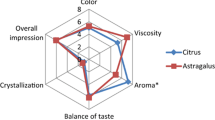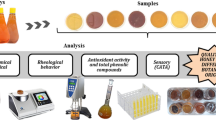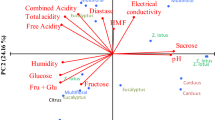Abstract
Alicante and Jijona turrón are honey- and almond-based confectionery products very famous in Spanish countries, especially during Christmas. In this study, the role of different types of honey (rosemary, orange blossom, and control—a mixture of sugars resembling the sugars composition of real honey) in the aroma and flavor of these confections was studied. Volatile compounds in turrón samples were extracted using simultaneous distillation–extraction and finally isolated, quantified and identified using GC-MS. Two different types of panels were used, trained and consumer, for studying the aroma and flavor intensities of turrón samples. Aldehydes, aromatic hydrocarbons and furans were the predominant chemical groups in turrón samples. The first conclusion was that terpenes and aromatic hydrocarbons decreased with the heating of the boixet step while pyrazines, furans, and pyrroles increased. Chemical feelings, such as cooling and pungency, are the best tool to discriminate among products containing and non-containing honey. Products containing honey were more aromatic and obtained higher satisfaction values than those prepared from a mixture of sugars.

Similar content being viewed by others
References
Chiralt A, Galotto MJ, Fito P (1991) J Food Eng 14:117–128
Lluch MA, Galotto MJ, Chiralt A (1992) Food Struct 11:181–186
Martínez N, Chiralt A (1995) J Text Stud 26:653–663
Martínez N, Chiralt A, Fito P (1997) J Food Eng 32:313–324
Martínez-Navarrete N, Fito P, Chiralt A (1996) Food Control 7:317–324
Maga JA (1983) Lebensm Wiss Technol 16:65–68
Blank I, Fischer KH, Grosch W (1989) Z Lebensm Unters Forsch 189:426–433
Golob T, Plestenjak A (1999) Food Technol Biotechnol 37:195–201
Serra Bonvehí J, Ventura Coll F (2003) J Sci Food Agric 83:275–282
Serra Bonvehí J, Soliva Torrentó M, Muntané Raich J (2000) J Sci Food Agric 80:507–512
Vázquez L, Verdú A, Miquel A, Burló F, Carbonell-Barrachina AA (2007) Eur Food Res Technol. doi:10.1007/s00217-006-0479-6
Dimick PS (1994) Manuf Confect January:45–48
Warner KJH, Dimick PS, Ziegler GR, Mumma RO, Hollender R (1996) J Food Sci 61:469–472
Alasalvar C, Shahidi F, Cadwallader KR (2003) J Agric Food Chem 51:5067–5072
Krist S, Unterweger H., Bandion F, Buchbauer G (2004) Eur Food Res Technol 219:470–473
Vázquez-Araújo L, Enguix L, Verdú A, García-García E, Carbonell-Barrachina AA (2007) Eur Food Res Technol. doi:10.1007/s00217-007-0717-6
Takei Y, Shimada K, Watanabe S, Yamanishi T (1974) Agric Biol Chem 38:645–648
Takei Y, Yamanishi T (1974) Agric Biol Chem 38:2329–2336
RTS (1982) Reglamentación técnico sanitaria para la elaboración, circulación y venta de turrones y mazapanes. Real Decreto 1787/82 (BOE 2/08/82) modified by Real Decreto 1167/90 (BOE 26/09/90)
Serra Bonvehí J (2005) Eur Food Res Technol 221:19–29
Vázquez-Araújo L, Verdú A, Carbonell-Barrachina (2008) Flav Fragr J (in press)
McLafferty F (2000) Wiley registry of mass spectral data, 7th edn. Wiley, New York
Vázquez-Araújo L, Pérez-Castejón V, Verdú A, Carbonell-Barrachina AA (2005) Alimentación Equipos Tecnología 10:92–98
Meilgaard M, Civille GV, Carr BT (1999) Sensory evaluation techniques, 3rd edn. CRC Press, Boca Raton
Stone H, Sidel JL (1993) Sensory evaluation practices, 2nd edn. Academic Press, San Diego
Fisher C, Scott TR (2000) Food flavors, biology and chemistry. Acribia S.A., Zaragoza (in Spanish)
Sunthonvit N, Srzednicki G, Craske J (2005) Drying Technol 23:1407–1418
Poquet Gómez R (2004) Aromatic composition of Jijona turrón, roasted almonds, and honey. Universidad Miguel Hernández, Orihuela (in Spanish)
Miquel Sirvent MMA (2004) Physico-chemical and sensory changes during honey and sugar concentration in the manufacturing of turrón. Universidad Miguel Hernández, Orihuela (in Spanish)
National Institute of Standards and Technology (NIST) (2007) http://webbook.nist.gov/chemistry/name-ser.html. Accessed December 2007
Author information
Authors and Affiliations
Corresponding author
Rights and permissions
About this article
Cite this article
Vázquez-Araújo, L., Verdú, A., Enguix, L. et al. Investigation of aromatic compounds in Alicante and Jijona turrón . Eur Food Res Technol 227, 1139–1147 (2008). https://doi.org/10.1007/s00217-008-0829-7
Received:
Revised:
Accepted:
Published:
Issue Date:
DOI: https://doi.org/10.1007/s00217-008-0829-7




